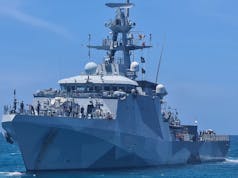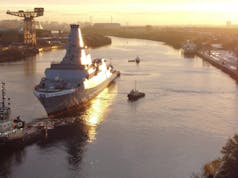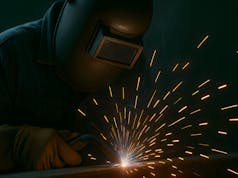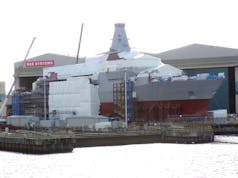Facilities to power the Royal Navy’s new supercarriers have taken a major step forward with the delivery of a frequency converter.
When at their home port, HMNB Portsmouth, HMS Queen Elizabeth and HMS Prince of Wales will be supplied with electricity through a new substation which has been built at the naval base by the Defence Infrastructure Organisation.
According to a press release, the frequency converter consists of 2 parts, the converter itself and the motor; each weighing 50 tonnes. The conversion is vital as ships all over the world operate on an electrical frequency of 60hz, but the National Grid is 50hz. The substation has been connected to the National Grid using about 2.6 miles of cable and supplies enough electricity to power a small town. The substation building has been complete for several months but fitting out continues.
Electricity will be supplied to the vessels using a hydraulic boom, which ‘plugs in’ to the side of the ship. The boom is being constructed in Italy and will be delivered in early 2017. The new aircraft carriers will be the biggest and most powerful ships in the history of the Royal Navy, projecting the UK’s global influence wherever they sail. They will be supplied with F-35B stealth fighter aircraft.
The release continues, “the work is being undertaken by VolkerStevin, who are also upgrading the jetty and installing navigational aids on behalf of the Defence Infrastructure Organisation.”
Philip Wise, DIO Project Manager, said:
“I’m delighted to see the delivery of the frequency converter, a clear sign of the progress we and VolkerStevin are making on these facilities. The substation is vital for HMS Queen Elizabeth and HMS Prince of Wales so we’re pleased to be playing our part in supporting the country’s new aircraft carriers.”
Gerrit Smit, VolkerStevin Project Manager, said:
“Achieving this key milestone is a fantastic step forward. It is such an important piece of infrastructure to be working on and we are delighted to be main contractor on a project which will have such a significant impact for the country.”
Merlin helicopters will be the first aircraft to begin flying from HMS Queen Elizabeth, soon followed by Apache, Wildcat, Chinook and F-35.
The information comes from a senior official said at the Farnborough air show.
The first supercarrier, Queen Elizabeth, is due to start sea trials next year before its first deployment in 2021, followed by its sister ship, the Prince of Wales.
It was stated that the Merlins will start simple flight activities in March 2017 and then first-class flight trials begin in early 2018.
Former First Sea Lord George Zambellas said:
“When the first of our new carriers, HMS Queen Elizabeth, deploys on her first mission in a few years, with fifth generation fighters and drones embarked, she will scotch at a stroke any talk of Britain’s retreat from the world.”
Tabloids often like to quote 12 as the maximum number of F-35B’s the carrier will be able to carry (despite the intention to purchase 138 in the long term), however this, as you probably know, is nonsense. The carriers, in peacetime, will usually deploy with 12 F-35B’s as a minimum and a number of various helicopters. To reduce costs and free aircraft for other commitments, the maximum aircraft complement will not usually be carried in peacetime, it instead will be supplied as required or deployed to the vessels in the event of a crisis. Rather than funding a large and permanent Carrier Air Group, the relatively new concept of a Tailored Air Group rather than fixed Carrier Air Group will be adopted for the Queen Elizabeth class with the exact types and numbers of aircraft embarked being adjusted to meet current requirements and threats.
The Queen Elizabeth class mark a change from expressing carrier power in terms of number of aircraft carried, to the number of sortie’s that can be generated from the deck. The class are not the largest class of carrier in the world but they are most likely the smallest and least expensive carrier the Royal Navy could build which still have the advantages that large carriers offer.
Crew are currently moving aboard the supercarrier, sea trials begin in the New Year and the vessel moves to Portsmouth in Spring 2017.













Just hope they got their sums right with these ! ! !
Shame it wasn’t built in Devonport.
Yeah, I wish it cost more and was smaller too.
Well the old carriers got in there !
Pompey is a shadow of its self.
Should centralise it at Devonport !
Better fleet support too
You only have BAE ?at Pompey
Sigh – I suggest you need to appreciate how much bigger and greater draft the QE class has. Frankly with the size of the Navy now we really don’t need 2 large bases so Devonport survived on the back of politics rather than anything else.
Hahaha
I understand how big they are.
I suppose with only a few war canoes Pompey is big enough
Devonport makes far more sense these days.
Pompey is only there as the admirals couldn’t be arsed to travel to far from London in the olden days
Ps it’s only banter
But you know Devonport will always be better ????
What’s with all the sighing?
And the difference it makes? ^^^
David Totten
Now we have 2 supercarriers do we have the capability to give the carriers the support they need?
Still another 18 million lines of code for the JSF guns to work.
Flexible air group – 12 strike aircraft in peace time with ability to surge more from usually land-based squadrons as necessary. Sounds like an innovative way to make the most of a limited defence budget which, let’s face it, most countries have outside of USA, China and Russia (Russia only because it’s willing to impoverish its citizens to keep military spending high). Maybe India included in that list, if not now then soon.
All good. Carry on!
Pity said carriers can’t land or let off a typhoon. Next our submarines will need swimming lessons BAE idiots.
Hi Steve, the Typhoon is not carrier capable, no carrier in the world can operate it and no Navy wants to.
Yes good points but range and effectiveness is compromised if we cannot despatch fighters from our carriers. The harrier did that well. Let’s hope that were thinking apache or the likes.
BAe did look at a navalised Typhoon for the Indian tender but it became clear that the conversion would be too expensive and inhibit its performance.
OK so here’s the question what are they carrying. Destroyers are faster and have more firepower. I sure hope they are not delivery vans for Oxfam. . We couldn’t afford them anyway. We really have to get a grip with our design objectives.
“Destroyers are faster and have more firepower.”
Hardly! The carriers are strike platforms so you need to look what 36 x F-35B can do vs a “destroyer” which I’ll take as a T-26 frigate since our destroyers (T-45) have only a single 4.5″ gun as offensive capability whereas the T-26 will have 24 x MK41 VLS which if loaded out with Tomahawk with 1000lbs warheads can deliver 24,000lbs of explosives on an enemy vs a QE class carrier flying a max of 110 sorties a day each potentially with about 16,000lbs of max weapons load which, assuming about half of that weight is warhead, translates to 880,000lbs of ordnance (and pretty much all of that able to hit moving targets) so absolutely no comparison in terms of firepower. As for speed, a destroyer can’t go supersonic so I think carrier strike wins on that one too.
Admittedly the F-35B weapons load above includes use of external pylons which compromises stealth. Due to smaller internal bay on F-35B you’re probably only talking about 2,000lbs of explosives carried only in internal bays but at 110 sorties that’s still potentially 220,000lbs of explosives vs 24,000lbs for 24 x MK41 VLS and the carrier can be replenished at sea whereas a frigate or destroyer needs to return to port to reload the MK41s.
They are designed and always have been designed to take the F-35 plus a compliment of helos.
Thanks Greg, that now makes sense as the USA and Australia use them as well.
Also Italy are buying some F-35B for its STOVL carrier so add them to the list. Spain also operates a STOVL carrier currently with Harriers so could be another F-35B customer although for now it’s said that it’s life-extending the Harriers until 2025 because it doesn’t have budget for a replacement. All in all there should be a decent set of countries using the B (STOVL) variant. It’s also good because not only is about 15% of the components for all F35 versions (primarily rear fuselage) made in the UK but also the lift fan that goes into everyone’s B versions comes from Rolls Royce so extra orders for UK industry from that.
I can’t see Spain ever buying ‘B’s, however Turkey might.
Spain no because of budget or other political reasons? Once Harriers go out of service they’re not going to have many other choices for Juan Carlos unless it goes all helicopter which I suppose is probably what will happen. Shame for them, given it does have a ski jump, but then again the Australians left the ski jump on theirs with no intention of going F-35B.
Another country recently rumoured to be looking at some F-35B was Israel, not for maritime deployment but on the basis that the nature of their local conflicts might make it necessary to use austere bases in some cases.